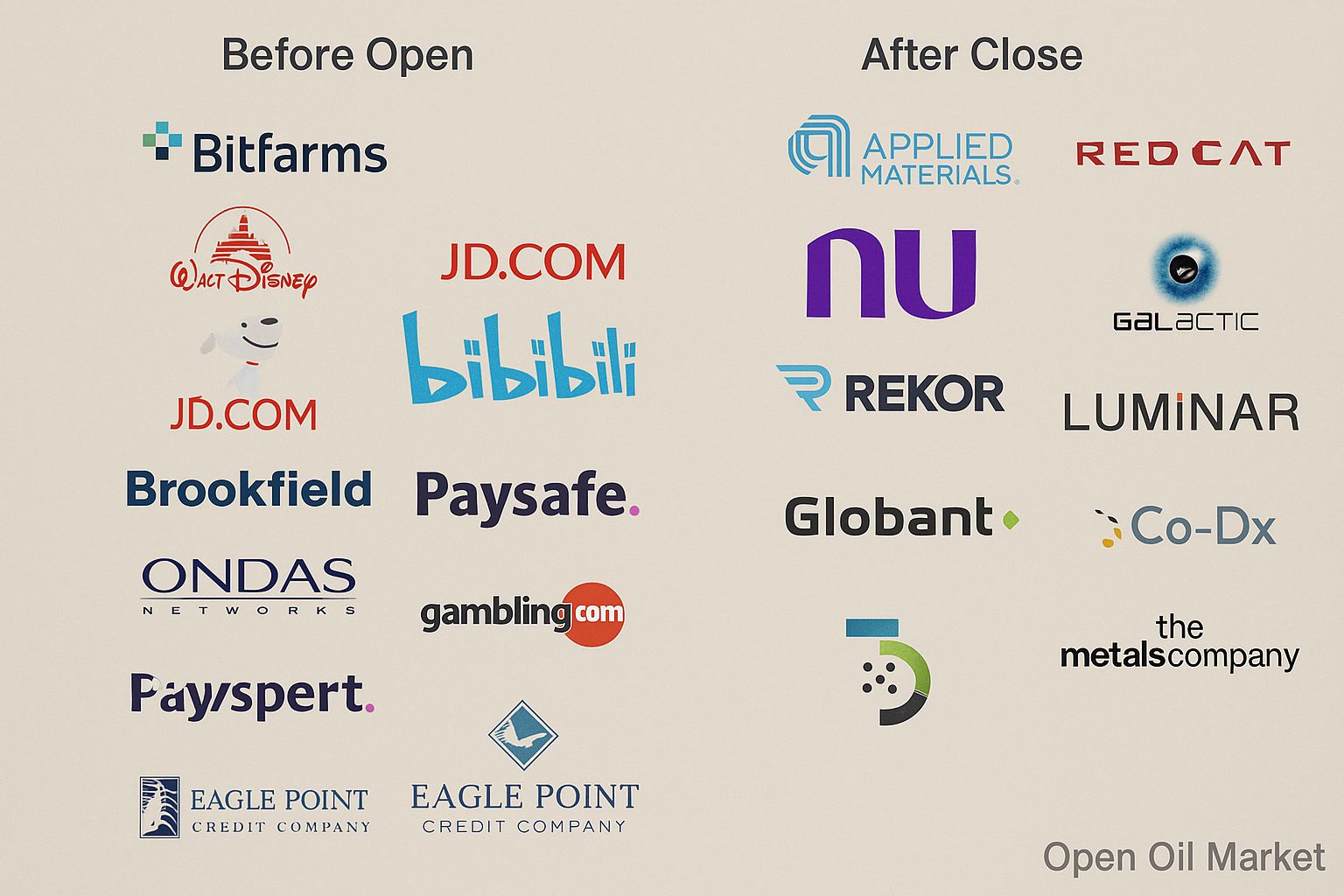
In-Depth Review of Economic Events and Corporate Reports for Monday, 27 October 2025. ASEAN Summit, US–China Trade Dialogue, US–Japan Leaders' Meeting, RBA Governor's Speech, Ifo Index, US Housing Market Data, and Corporate Results from the US, Europe, Asia, and Russia.
Monday presents a packed agenda for the markets: in Asia, the focus remains on the second day of the ASEAN summit, where the US and China are negotiating trade, and US President Donald Trump is meeting with Japan's new Prime Minister. In Europe, investors are tracking business sentiment in Germany through the Ifo index, which reflects the state of the EU's largest economy. In the US, attention is drawn to statistics on durable goods orders and the housing market, providing fresh signals about economic momentum in the third quarter. On the corporate front, a large series of earnings reports is expected from public companies, ranging from American technology, industrial, and financial corporations to key issuers from Europe, Asia, and Russia. Investors will have to weigh the interconnected factors: geopolitical signals ↔ risk appetite ↔ dynamics in commodity and currency markets; macroeconomic data ↔ Fed rate expectations ↔ bond yields ↔ interest in equities.
Macroeconomic Calendar (MSK)
- 11:15 — Australia: Speech by the Governor of the Reserve Bank (RBA).
- 12:00 — Germany: Ifo Business Climate Index (October).
- 15:30 — USA: Durable Goods Orders (September).
- 17:00 — USA: New Home Sales (September).
- 17:30 — USA: Dallas Fed Manufacturing Index (October).
International Agenda: ASEAN Summit and Negotiations
- ASEAN Summit (Day 2) - Southeast Asian leaders continue their meetings in Kuala Lumpur, discussing regional security and economic cooperation. The day before, progress was made at the summit under the mediation of Donald Trump, including an extended peace agreement between Thailand and Cambodia and agreements between the US, Malaysia, and Thailand on critical minerals. These successes set a positive tone and strengthen the bloc's integration (with Eastern Timor joining ASEAN).
- US–China Trade Negotiations - During the summit, American and Chinese representatives are holding ministerial dialogues in an attempt to ease the trade tensions between the two leading economies. Following the meetings, a "successful framework" for future negotiations has been established, with Donald Trump expressing confidence in reaching a deal with China's President Xi Jinping in the near future. Any signs of rapprochement are diminishing global trade risks and may bolster demand for risk assets in Asian markets.
- Meeting of US and Japan Leaders - Trump is engaging in separate talks with Japan's new Prime Minister (likely Shigeru Ishiba) during the summit. The aim is to reinforce the bilateral alliance and discuss trade and economic cooperation. Topics of discussion include security coordination in the Asia-Pacific region and trade agreements between the US and Japan. Confirmation of robust allied relations and any new economic agreements will positively influence investor confidence in regional stability.
Australia: RBA Governor's Speech
- RBA Governor's Speech - RBA Governor Michelle Bullock will deliver a speech at 11:15 MSK. Markets will closely listen for any hints on the regulator's future policy: comments on inflation, the labour market, and the state of the Australian economy could impact the Australian dollar and local equities. If Bullock signals a shift in rhetoric (e.g., an intensified focus on fighting inflation or, conversely, a readiness to support growth), this could immediately reflect on rate expectations in Australia.
Europe: Ifo Index in Germany
- Ifo Business Climate Index - The October Ifo Business Climate Index for Germany will be published by the Ifo Institute. This survey of approximately 9,000 companies provides an assessment of current conditions and expectations. In September, the index declined (to 87.7 points), reflecting business caution. An unexpected rise in the index for October would signal a easing of recessionary pressures and support the DAX and the euro. Conversely, a further decline in the Ifo index would heighten concerns about Germany's economy and could prompt investors to adopt a defensive strategy in the European market.
US: Orders, Housing, and Manufacturing
- Durable Goods Orders - A key indicator of business investment demand in the US. Data for September will reveal whether orders have recovered after a possible decline in August. Core orders (excluding volatile transport items) are especially important: their increase would indicate confident capital investments by companies and support shares in the industrial sector. Conversely, a more significant than expected decline in orders would raise alarming signals of an economic slowdown and may weaken the dollar's position (through expectations of a softer Fed policy).
- New Home Sales - Report on the residential real estate market for September. High mortgage rates have cooled demand: a slowdown in new home sales was observed earlier in the third quarter. Investors will assess whether this trend has continued. A further decline in new home sales would amplify concerns for the construction sector and related industries (developer bankruptcies, decreased demand for furniture and building materials). In contrast, unexpectedly strong sales would indicate buyers' adaptation to the rates, benefiting the shares of home builders.
- Dallas Fed Manufacturing Index - The first regional glimpse into the US manufacturing sector for October. The Texas Fed conducts monthly surveys of manufacturers; previous months have shown negative indices, indicating contraction. Should the index show growth (even if remaining negative, but closer to zero), it may suggest that the industrial bottom is near and that the fourth quarter has begun on a more positive note. Conversely, ongoing weakness (deeply negative values) would confirm continued pressure on the manufacturing sector, especially given high rates and a strong dollar.
Earnings Reports: Before Market Open (BMO, US and Asia)
- Keurig Dr Pepper (KDP) - An American beverage manufacturer (S&P 500). Key metrics include sales volumes of popular beverage brands and pricing dynamics. Investors will assess how the company is maintaining margins amid rising costs and changing consumer preferences, as well as any updates to its annual forecast.
- Canon Inc. - Japan, a global electronics and optics conglomerate. Focus areas include demand for cameras, printers, and equipment; a weak yen may enhance Canon's competitiveness and export revenue. The market will respond to the company's comments on global demand for office equipment and photographic products, as well as plans for developing new segments (e.g., medical optics or semiconductor equipment).
- POSCO - South Korea, one of the world's largest steel producers. Key attention will be on steel price dynamics and shipping volumes. POSCO's results serve as a barometer for industrial demand in Asia, particularly given the situation in the Chinese economy. Improvements in profit and shipping volumes will indicate a revival in infrastructure and construction projects, while a weak report will intensify concerns about a downturn in the industry.
- Qantas Airways - Australia's leading airline. Investors are monitoring the recovery of passenger traffic: the third-quarter release will reveal how well the airline is filling seats and maintaining high fares in the face of expensive jet fuel. Important metrics include load factors and yield per kilometre; strong Qantas results affirm resilient post-pandemic travel demand, while declining profits may signal cost pressures and competition in the airline industry.
Earnings Reports: After Market Close (AMC, US)
- Cadence Design Systems (CDNS) - A software developer for chip design (EDA). The market's attention will be on demand for Cadence's tools from semiconductor companies. The AI investment boom is stimulating new chip projects, and investors are hoping for an increase in orders for design software. The business's margins and Cadence's forecast will also be significant: a positive outlook for the upcoming quarters could drive up the company's and the entire software sector's shares.
- NXP Semiconductors (NXPI) - A semiconductor manufacturer, a key player in automotive electronics and communication chips. The report's key focus is on demand from the automotive sector and industrial IoT, inventory levels at clients, and management's forecast. If NXP reports stable revenue growth and reduced excess semiconductor inventories, it will strengthen confidence in the recovery of the global chip sector; however, weak results or a cautious outlook may temporarily dampen optimism regarding tech shares.
- Welltower (WELL) - An American real estate investment trust (REIT) in the healthcare and senior living sector. Focus areas include operational indicators of properties – occupancy rates in care facilities, rental rates, and funds from operations (FFO). The healthcare REIT sector is sensitive to rates: investors want to see rental income growth compensating for higher financing costs. A reliable stream of rental payments and a positive forecast from Welltower could bolster interest in dividend-paying real estate securities, despite high rate levels.
- Waste Management (WM) - The largest waste management operator in the US. Key indicators include waste collection and disposal volumes in the commercial and construction segments, as well as pricing policies for services. Growing waste volumes typically reflect an increase in economic activity – investors will check if WM's services continue to be in demand from both industry and households. Additionally, the company's stable profitability amid rising costs will signal business resilience and, indirectly, the health of the economy.
- Nucor Corp. (NUE) - Leading American steel company. The market's focus is on Nucor's profitability amid volatile steel prices. Prices corrected from peaks in the second and third quarters – data on margins and new orders are important. If Nucor maintains strong sales due to construction and automotive demand, it would be a positive sign for the entire steel sector. However, declining profitability would heighten concerns that construction slowdowns and high rates are pressuring metal consumption.
- The Hartford (HIG) - An American insurer and financial group. Important aspects include losses from catastrophes (hurricanes and natural disasters in Q3) and investment income. The third quarter traditionally includes the hurricane season in the US, and the scale of insurance payouts will impact net income. At the same time, rising rates may have enhanced the yield of HIG's bond portfolio. Investors will assess the balance: whether the company weathered the blow from catastrophic payouts and has benefited from investment income. Hartford's results will set the tone for the entire US insurance sector in the context of risk management and capital.
Other Regions and Indices: Euro Stoxx 50, Nikkei 225, MOEX
- Euro Stoxx 50: Among blue chips in the eurozone on 27 October, there are few major corporate reports. European markets will be more reactive to the macro background (for example, the Ifo index and the outcomes of the ASEAN summit meetings). Noteworthy releases in Europe on this day include Lonza Group's financials (Switzerland, pharmaceutical services) and Deutsche Börse (Germany, exchange operator). While important within their sectors, their influence on the broader market remains limited, so the main drivers for Euro Stoxx 50 will continue to be overall market sentiment and economic data.
- Nikkei 225 / Japan: The quarterly earnings season continues for Japanese companies. Many participants in the Nikkei index will release results for April–September (the first half of the 2025 financial year). Among these are industrial and technology giants (such as Canon, Nidec, and automotive manufacturers) whose performance impacts the index. A weak yen may have supported exporters, hence strong sales and profits are anticipated in export-oriented sectors. If the majority of reports turn out to be positive, the Nikkei will gain momentum for growth; a series of disappointments may slow down the rally in the Japanese market.
- MOEX / Russia: Monday stands out in the Russian market with the financial reporting of X5 Group (the largest retailer in the grocery segment). X5's results for the first nine months of 2025 reflect the state of consumer demand in Russia: double-digit revenue growth in previous quarters was anticipated due to network expansion and increases in comparable sales. Fresh figures will indicate whether the high pace is being maintained. In other respects, the week on MOEX is relatively calm: a number of mid-cap companies (including those in gold mining and power generation) will disclose operational indicators, while the main wave of quarterly reports from Russia's largest corporations is expected in November.
End of Day: Key Investor Takeaways
- Geopolitical Signals: Progress at the ASEAN summit and in US–China negotiations. Any reduction in international tensions (trade deals, ceasefires) boosts risk appetite: emerging market currencies and stocks benefit, while industrial metals rise. However, should new contradictions arise during the meetings, the reverse effect may occur – an increase in demand for safe-haven assets (yen, franc, gold).
- European Economy: Reaction to the Ifo index in Germany. This indicator will test business sentiment in the EU. An improvement in the Ifo index will bolster the euro and shares of cyclical European companies (automotive, banks), indicating the start of a recovery. Conversely, a drop in the index will heighten recession fears – potentially leading to GDP forecast downgrades for Germany and pressure on European exchanges.
- US Statistics: Data on orders and housing as a reflection of the health of the US economy. Strong reports (growth in orders, high home sales) may compel the Fed to maintain a hawkish tone – anticipate rising treasury yields and a stronger dollar, which could weigh on gold and emerging markets. Conversely, weak data may intensify discussions about the peak of rates being near: this would be positive for equities, especially in the growth sector, and for commodity prices.
- Corporate Reports: Individual companies can influence sector sentiment. Key focus before the market opens includes Keurig Dr Pepper (consumer sector), while after the close, attention turns to tech companies Cadence and NXP. Their results and forecasts may locally shift the emphasis: for instance, a strong report from Cadence could support confidence in a "chip rally," while weak figures from NXP may caution investors in the tech sector. X5 Group's report will also be intriguing as an indicator of consumer demand in Russia.
- Risk Management: The multifactorial news backdrop on Monday (geopolitical, macro, earnings) may increase volatility. Investors should pre-determine acceptable ranges for key assets’ movements and set stop orders accordingly. Particular attention should be paid to the timing of key data releases (e.g., 15:30 MSK in the US): sharp fluctuations may occur during these moments. Thoughtful hedging positions and diversification will help navigate a day rich in events while managing risk effectively.




